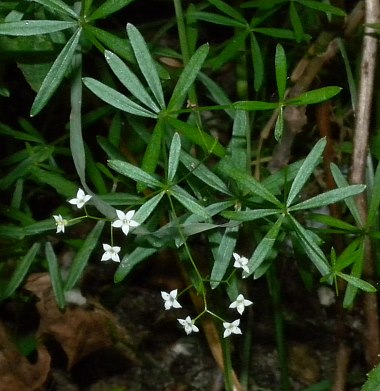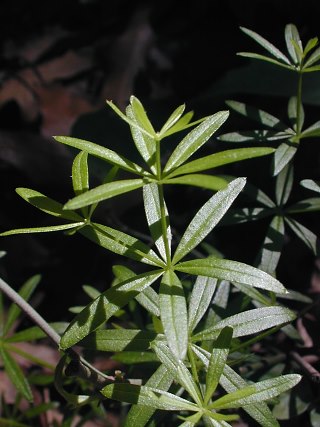
The upper stems terminate in either small cymes or large panicles of flowers; the size of an inflorescence is variable depending on the size of the plant and environmental conditions. Each inflorescence is abundantly branched, terminating in groups of 2-3 flowers on short divergent pedicels. The pedicels of the flowers are light green, angular, and hairless. Each flower is about 1/8" across or a little less, consisting of a white corolla with 4 pointed lobes, 4 stamens, 2 styles, and a 2-celled ovary that is without bristles. Each cell of the ovary is globoid-ovoid in shape and joined together with the other cell along one side. The blooming period occurs during early summer, lasting about 2-3 weeks. The flowers are later replaced with smooth 2-celled fruits that change color from light green to purple and finally brown. Each cell of the fruit usually contains a single seed (or sometimes none). The root system is fibrous and rhizomatous. Small colonies of plants often develop from the rhizomes.

Cultivation: The preference is medium shade to dappled sunlight, mesic to dry conditions, and soil containing loam, clay-loam, sand, or rocky material with decaying organic matter. This bedstraw is more tolerant of dry conditions than most species in its genus. It could be cultivated as a ground cover underneath trees.
Range & Habitat: The native Shining Bedstraw is common throughout Illinois (see Distribution Map). Habitats include rich mesic woodlands, upland woodlands, open rocky woodlands, sandy woodlands, upper slopes and tops of bluffs, shaded cliffs, and woodland edges. Generally, this bedstraw is found in upland wooded areas where deciduous trees, especially oaks, are present.
Faunal Associations: The small flowers are cross-pollinated by small bees and flies, including Masked bees (Hylaeus spp.), Halictid bees (Lasioglossum spp.), and Syrphid flies. These insects suck nectar from the flowers. Other insects feed on the foliage, flower tissue, or plant juices of Galium spp. (bedstraws). These insect feeders include the caterpillars of such moths as Epirrhoe alternata (White-Banded Toothed Carpet), Lobocleta ossularia (Drab Brown Wave), and Hyles gallii (Galium Sphinx). Another insect, Myzus cerasi (Black Cherry Aphid), uses bedstraws as summer host plants. Because the stiff bristly hairs of the leaves can cling to passing objects, animals may play a minor role in distributing the seeds to new locations.
Photographic Location: The photographs were taken at a wooded bluff in east-central Illinois and the edge of a sandy woodland in NW Indiana.
Comments: Shining Bedstraw can be identified by its attractive shiny leaves in whorls of 6, its smooth fruits, and its preference for upland wooded locations.